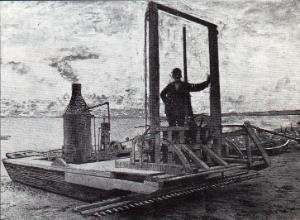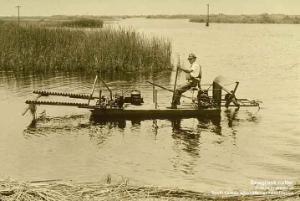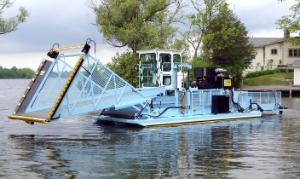Little thought is given to aquatic weeds unless you live or recreate on the worlds waterways. The aquatic plant harvester industry has grown in response to those concerns.
With Pictures of steam powered cutter boats dating back to the late 1890’s, we know that excessive plant growth has been a problem for a long time. At first, the problem was dealt with manually. People came up with clever tools to help make weed cutting easier. Others tried hand pulling the plants, but the going was slow.

Hockney weed cutter
The true origins of the harvesting industry began with a weed cutter boat built by the Hockney Company in Silver Lake, Wisconsin, in 1903. It is interesting to note that this machine was not originally built to meet recreational purposes; it was made in response to fussy Chicago housewives! Around the turn of the century, ice was harvested from Wisconsin lakes destined for Chicago iceboxes. The housewives there didn’t like cleaning out the weeds when the ice melted. Hockney designed this small boat, which featured a reciprocating cutter bar and duck-feet-like paddles for propulsion, to cut down the weeds in the fall so that clean ice could be harvested in the winter.
From this modest beginning many attempts were made to modify and improve these early cutter boats. In the early 1960’s, brothers John and Doug Dauffenbach founded D&D Products Incorporated located in North Prairie, Wisconsin and began manufacturing a more modern harvester which are still in production today, operating as Aquarius Systems. Like an underwater lawn mower, an aquatic weed harvester simultaneously cuts the vegetation, collecting and storing the weeds on board. The cutter head located on the front of the harvester uses sickles similar to those found on farm equipment, and generally cuts from one to six feet deep. A conveyor belt on the cutter head, which is always in motion, brings the clippings onboard the machine for storage. Once full, the harvester travels to shore to discharge the load of weeds.

Prototype aquatic weed harvester
Harvesters come in a variety of sizes, with cutting swaths ranging from four to twelve feet in width and up to five or six feet deep. The onboard storage capacity varies as well, and is measured in both volume and weight. Harvester storage capacities generally range from 100 to 1000 cubic feet of vegetation by volume, or from one to eight tons. They are usually propelled by two paddle wheels that provide excellent maneuverability and will not foul in dense plant growth. Harvesters may be propelled by twin hydraulically powered props.
Mechanical harvesters offer an environmentally sound method of controlling nuisance vegetation. As these weeds are removed from the lake, the water is immediately ready for use and there are no restrictions on use of the area that might be experienced with herbicide or some biological control treatments.
Removal of this biomass prevents its eventual decay and settling to the bottom, helping to reduce sedimentation in the lake. There is some nutrient removal with harvesting too, as the nitrogen and phosphorous that is bound up in the plant exits the water body. Harvesting is usually not lethal, leaving behind an oxygen and habitat producing plant, which is often desirable.

Aquarius Systems aquatic weed harvester
The aquatic weed harvester has come a long way from its crude and cumbersome origins. The future holds infinite possibilities. Some of the concepts being researched include: New paddle wheel designs for greater efficiency, a new hull design that more closely resembles the hull of a boat, and a remote controlled transport barge. We’re also researching ways to turn the harvested plant material into a marketable product. As the hydraulics industry evolves, this too will have an impact on changes in the harvesting industry.
We cannot be entirely sure how the harvester of the future will look, but with nuisance aquatic plant growth reaching epidemic levels globally, the industry is certain to be around for many years to come. We’ve learned over many, many years that nothing is impossible.
From the Aquatic Weed Harvester Blog, posted February 6, 2012 by Aquarius Systems. Permission to repost granted.
